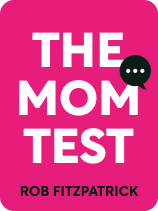

This article is an excerpt from the Shortform book guide to "The Mom Test" by Rob Fitzpatrick. Shortform has the world's best summaries and analyses of books you should be reading.
Like this article? Sign up for a free trial here.
How do you learn how to develop your business? How can customer feedback help your business?
If you’re having trouble thinking of the next step for your business, Rob Fitzpatrick’s book The Mom Test has you covered. After you have conversations with customers, you should show a prototype of your product to potential customers.
Continue reading to learn how to develop your business with Fitzpatrick’s advice.
Use Discussions With Customers to Develop Your Business
Fitzpatrick recommends developing a prototype of your product or service as quickly as possible to know how to develop your business. As we’ll see, discussions with customers look a bit different after you reach this stage, and having a prototype to show off will make these conversations easier.
(Shortform note: Fitzpatrick recommends developing a prototype as quickly as possible, but he doesn’t give specific tips on how to streamline the development process. In Sprint, Jake Knapp recommends a process he calls the “Design Sprint”: Challenge yourself to transform an idea into a working prototype within a five-day workweek. This bare-bones prototype only needs to create the illusion of being a complete product for you to get accurate feedback from customers.)
Push Customers to Commit to Your Business
Once you have a prototype to show, you can set aside the Mom Test and start pitching your product to customers. This is because, at a certain point, the only way to objectively verify that your product is valuable is by convincing people to sacrifice something for it. In sales, this is known as “commitment.”
Before your discussions with customers, Fitzpatrick suggests identifying the specific way you’d like the customer to commit to the business, so you have a goal to aim for. Frequently, this means trying to convert the potential customer into an actual customer by asking them to put money down, but there are other ways customers can demonstrate their commitment. Rather than money, they may commit their time (for example, by agreeing to let you film them for a product testimonial) or their reputation (for example, by posting on social media about your product). If your product is truly valuable, there’s a good chance that potential customers will be excited to commit to it.
Fitzpatrick states that pushing for commitment after a meeting always results in a win: You either get a commitment that moves your business forward, or you get a rejection that yields valuable information (it either highlights your product’s flaws or indicates that you’ve met with someone outside your customer segment).
Don’t Push Too Hard for Commitment
Many sales experts believe that Fitzpatrick’s advice to set a commitment goal and push toward that goal is the cornerstone of sales. For example, in SPIN Selling, Neil Rackham explains that many salespeople swear by “closing techniques,” psychological tricks that subtly influence customers to commit. One closing technique is to ask questions that assume the customer has already agreed to purchase, like “How many can I order for you?”
However, using these techniques to doggedly push for commitment has risks. Rackham argues that if the potential customer feels you’re trying to pressure them into a quick purchase, they may assume you’re trying to manipulate them, and you’ll lose their trust.
The larger the commitment you request from the customer, the less effective aggressive closing techniques will be. In other words, avoid using closing techniques if your product is expensive, if you’re asking for a significant amount of your customer’s time, or if you’re asking them to risk a very prestigious reputation, like asking a well-respected critic to endorse your product.
This is why you must give the potential customer a product they’re excited to commit to, as Fitzpatrick advises. To pitch such a product more effectively, Rackham suggests giving the potential customer plenty of time to ask questions or express concerns so they can learn why they should be excited about the product. In contrast, if you push for commitment too quickly, they’ll suspect you’re trying to hide something bad about the product.
Fitzpatrick’s advice to see every push for commitment as a victory, even if you don’t make the sale, may help you avoid falling into the trap of pushing too hard. Once you understand that the information you get from rejection is valuable and will help you get more sales in the future, you won’t feel pressured to make every sale and resort to closing techniques that may alienate your potential customers.
Scout for Advisors, Not Sales
When you push for customers to prove their commitment to your business, you’ll often end up turning feedback conversations into sales. However, Fitzpatrick recommends going into these conversations with the goal of finding long-term advisors, not making sales. Advisors—people who give you consistently accurate feedback over time—are valuable if you can stay in contact with them. More importantly, by making it your primary goal to judge the quality of the customer’s advice, you’ll feel more confident and in control than if you spend the meeting hoping you’re good enough to land a sale.
(Shortform note: Throughout The Mom Test, Fitzpatrick speaks from experience selling directly to businesses. Here, he implies that most of the time, your ideal customers would also make good advisors (because he assumes that they’re industry professionals). However, if you’re selling directly to consumers, your ideal customers are unlikely to be reliable long-term advisors. In this case, you may need to separate your pursuit of advisors from your pursuit of customer feedback rather than using the “two birds, one stone” approach Fitzpatrick offers here.)

———End of Preview———
Like what you just read? Read the rest of the world's best book summary and analysis of Rob Fitzpatrick's "The Mom Test" at Shortform.
Here's what you'll find in our full The Mom Test summary:
- How to ask the right questions to receive brutal honesty from anyone—even your mom
- How to use the “Mom Test” to gather objective feedback about your business or product
- How to extract the most important information from feedback conversations






